TOP OET Listening Part A Guide with Sample Audios
- 34 Comments
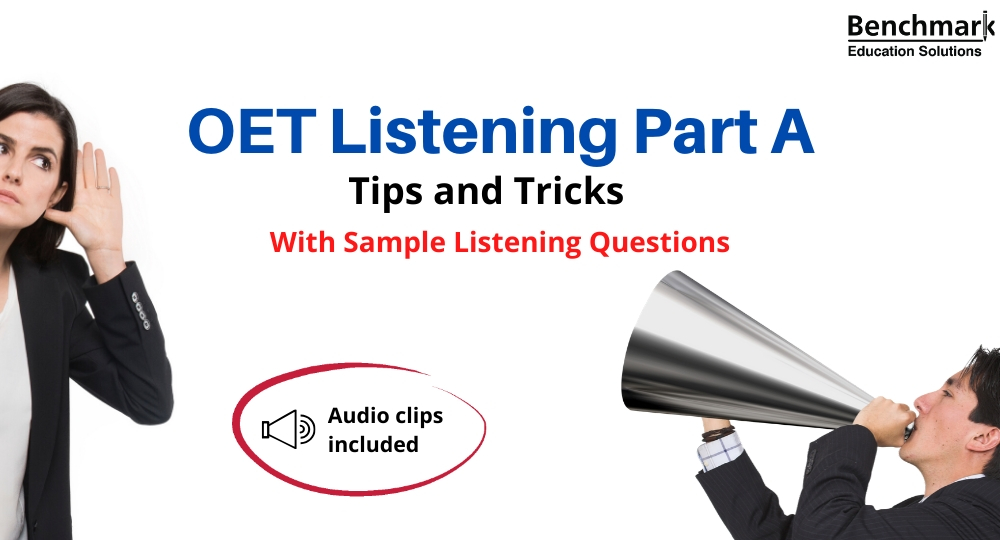

The OET Listening sub-test consists of 42 questions spread over 3 parts – Part A, B and C. Part A consists of fill-in-the-blank questions while Parts B and C are multiple-choice questions. Here is a summary of how the listening test questions are spread.
Table of Contents
| OET Listening sub-test | ||
|---|---|---|
| Section | Number of questions | Question type |
| Part A | 24 questions | Fill in the blanks |
| Part B | 6 questions | Multiple choice (choose from 3 options – A, B or C) |
| Part C | 12 questions | Multiple choice (choose from 3 options – A, B or C) |
As you can see, Part A alone has more questions (24 questions) than Parts B and C combined (18 questions combined). It is also a section where it is more difficult to make a guess because you will have to fill in a blank. For Parts B and C, you can still choose one option in the multiple-choice and have a better likelihood of getting it right (one-in-three possibility of getting it right). There are some listening strategies which you need to learn in order to ensure that you can get a better grade.
This top guide will give you some valuable test day tips on how to approach Part A, with sample questions and audio recordings.
Before proceeding to the tips, you need to take note of some basic information regarding this section of the test.
Listening Part A Format
- Part A consists of 2 different extracts. Extract One will contain 12 questions and Extract Two will contain another 12 questions.
- You will be given 30 seconds to look at the 12 questions for each extract before the recording is played. This reading time is VERY IMPORTANT. You need to read the questions (either Questions 1-12 or Questions 13-24) quickly before you listen so that you know what to expect.
- You need to write down the EXACT word or phrase that you hear from the extract.
- However, the questions may be paraphrased and you may not hear the particular section word-for-word. You will need to decide which word/phrase will fit into the blank.
- You will not be penalized for spelling mistakes if the mistakes are minor and do not distort meaning. For instance, if a word is spelt with double ‘L’s but you only wrote on ‘L’, it can still be accepted. However, if your spelling distorts the meaning of the word and it means something else, then it may not be accepted. Similarly, if your spelling is too far off from the way the word is pronounced, it may not be accepted as well.
Now, let’s look at some OET listening strategies, with sample questions and audio recordings. Here are the top 4 listening strategies you need to know.
LISTENING STRATEGY 1
PREDICT THE ANSWER BY LOOKING AT WORDS BEFORE AND AFTER THE BLANK
As you are reading the questions, you can start to predict the answer. Let’s look at Example 1:
Patient: Seth Kelly
Reason for visit: Routine check up
Medical History
- Stage five 1) (diagnosed 2 years ago)
- Being treated at specialized clinic for renal problems
- Began haemodialysis 2)
- Also suffers from 3)
- No reports of breathing problems
If you look at Question 1, read the words before and after the blank. It says ‘Stage 5’ and ‘diagnosed 2 years ago’. You can safely predict that this blank would likely be the name of an illness.
Move on. Look at the next point. It says ‘Being treated at specialized clinic for renal problems’. Look at the subsequent point. It says ‘Began haemodialysis…’. All these are common clusters for kidney issues. As a medical professional, you can predict that the answer to Question 1 may be related to a kidney issue. So, when you listen, you are watching out for that to confirm your prediction.
Let’s look at Question 2 at the same time. It says ‘Began haemodylisis’ before the blank. Can you predict what the answer may be? Possibly it is a date or a time frame. Can it be ‘on 1 March 2018’? Can it ‘2 months ago’? Yes, possibly.
Now, listen to the audio sample for this portion of the test and let’s see if your predictions are correct. Remember to keep an open mind and listen carefully because sometimes you may predict wrongly and the answer may be something unexpected.
So, what is the answer to Question 1? Yes, it is ‘Chronic kidney disease’. The earlier prediction was right!
What about the answer to Question 2? Here, the prediction was not totally on point. The prediction was a date or time frame, but neither was mentioned. However, the patient said “I recently decided to have haemodialysis”. Therefore the answer for Question 2 is ‘recently’.
The bullet points should thus read:
- Stage five 1) chronic kidney disease (diagnosed 2 years ago) and
- Began haemodialysis 2) recently
NOW, YOU TRY.
Exercise 1
Patient: Vance Godfrey
- Reason for Appointment: Ongoing complex 13)in right foot heel condition
Exercise 2
Current Condition of Patient
- Needs to check for direct bilirubin concentration
- Possibly idiopathic neonatal 7)or biliary atresia hepatitis
LISTENING STRATEGY 2
BE PREPARED TO HEAR A DIFFERENT STRUCTURE IN THE SENTENCE
In Part A, you will sometimes hear the same words in a chunk of text exactly as what you see in your question paper. For instance, in the earlier example, for Question 1, the bullet point was ‘Stage 5 ___________’ and the extract that you heard was ‘Stage 5 chronic kidney disease’. That’s easy and simple because you hear exactly what your eyes are seeing.
However, it may not always be that simple. Sometimes, you may not hear exactly the same words before or after the blank where your question is. Let’s look at Example 2.
Example 2
Current Condition
- Feeling 4)and weary (impacting social life)
- 5)is not affected
The answer to Question 4 is ‘very tired’, so the bullet point should read
- Feeling very tired and weary (impacting social life)
but what you heard was “I have been feeling very tired recently to the point of weariness”. While the word ‘feeling’ is present in both the question and the extract, the words ‘and weary’ on paper has been changed to ‘to the point of weariness’ in the extract.
What about Question 5? The blank is about something which is not affected. The answer should be ‘memory’, so the bullet point should read:
- 5) Memory is not affected
but you heard ‘Any problems with your memory?’ and the answer was ‘No, not that I can think of. The tiredness mostly affects my social life.’
Question 5 is a little tricky because the word ‘affects’ is linked to ‘social life’. However, the question is asking about what is NOT affected. So you will need to listen carefully. When the doctor asked if there was any problem with the patient’s memory, he replied ‘no’, so the answer should be ‘memory’.
NOW, YOU TRY.
Exercise 3
Next Steps
- May need to commence 23)if kidneys are damaged dialysis
Exercise 4
Patient: Alex Summers
- Reason for Appointment: Hand 1) 1) lesions
History of Condition
- Recurring condition
- Current outbreak began 2)ago 2) 5 / Five days
- Audio Transcript
- Answer
LISTENING STRATEGY 3
BE PREPARED TO HEAR SYNONYMS IN THE EXTRACT
A synonymous expression may be used for a word you see in your listening question paper. Let’s look at Example 3.
Example 3
Current Condition
- Shuns 6) meals
- In retrospect, negative feelings can be traced to the patient’s 7)
- Reports past episodes of emotional and 8) abuse
- Had trouble fitting in at school
Let’s look at Questions 6 & 7 in Example 3. In particular, look at the words ‘shun’ and ‘in retrospect’.
The answer to Question 6 is ‘family’. However, you do not hear the word ‘shun’ in the extract. Instead, the synonym ‘avoiding’ was used. So what did the patient avoid? He said, “Also, I have been avoiding everyday activities I usedto enjoy, like having a meal with my family.” Since Question 6 is asking about ‘meals’, then the best answer is ‘family’, so the bullet point should read:
- Shuns 6) family meals
What about Question 7? The question says ‘In retrospect’. That means, looking back at the past. You will NOT hear ‘In retrospect’ in the extract. However, the patient did say, “Looking back on it now, my teenage years were filled with frequent periods of emotional abuse”. So the correct answer is ‘teenage years”, and the bullet point should read:
- In retrospect, negative feelings can be traced to the patient’s 7) teenage years
NOW, YOU TRY.
Exercise 5
Patient’s age: 1 month old
Background
- Second child
- Full term baby
- Weight at birth: Below 2) kilos 3 / Three
Exercise 6
Injury
- Sustained 6 hours ago
- Impact on 1) of patient’s head (by another player’s knee) (the) right side
- Patient cannot recall incident
LISTENING STRATEGY 4
BE ON THE LOOKOUT FOR A COLLECTIVE WORD THAT MAY REPRESENT A GROUP OF WORDS
Sometimes, instead of a synonymous expression, a collective word may be used to represent a group of words. Let’s look at a simple example. Instead of saying ‘pigeons, crows, sparrows and doves’, we can just use one word to represent them, and that is ‘birds’.
What out for these words in your OET Listening sub-test as well. Let’s look at Example 4.
Example 4
Recent Symptoms
- Ongoing symptoms for a week
- Overall feelings of 1)
- Reduced appetite but has 2) once
- Reports slight fever during this time
- Reports 3)in joints
Let’s take Question 3 in Example 4 as a case in point. The question wants you to listen for something that happens in the joints.
The answer to Question 3 is ‘aching pains’. In the extract, you do not hear the word ‘joints’ but the patient mentioned ‘I have had these aching pains in my knees, elbows, and wrists’. The ‘knees, elbows and wrists’ are collectively ‘joints’, so the patient’s description of them is the answer, which is ‘aching pains’. The bullet point should thus read:
- Reports 3) aching pains in joints
NOW, YOU TRY.
Exercise 7
Equipment Recommendations
- For social health, place new equipment in 23) (the) main lounge
And there you have it! Simple tips for you to help you in Part A of the OET Listening sub-test. It does take practice though. Listening is about concentrating as well as thinking at the same time. You will need to listen carefully and process that information in a meaningful way. In addition, you are also expected to write down your answers as you listen! This is where practice comes in. As you do more practice, you will get better at it so that by the time you sit for the test, you are comfortable utilizing all the listening skills required for the test.
Stay tuned for our article on how to handle Part B and Part C of the OET Listening sub-test.
Free Writing OET Materials
1. OET Writing Materials for Nurses
2. OET Writing Materials For Doctors



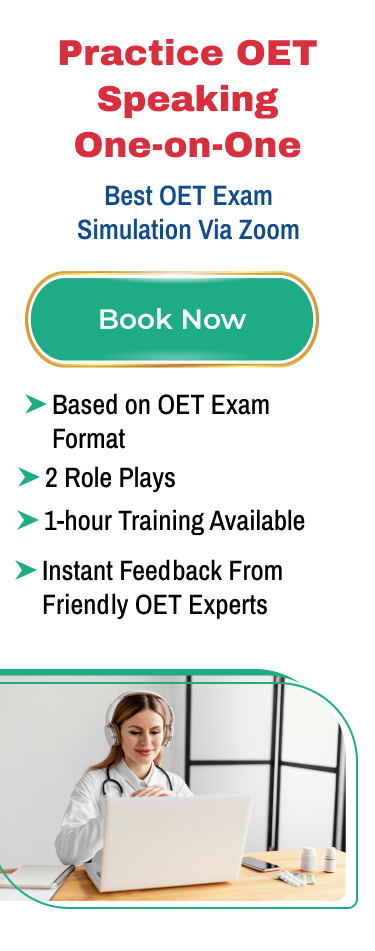



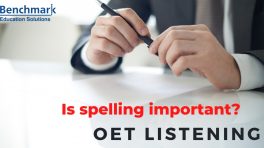


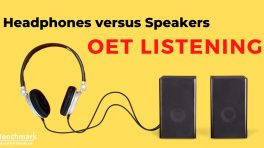
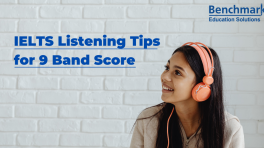





Really useful….tnx u soo much
its helpful. need more help please. I’.m very weak in listening ,but you gave me a good support.THANK YOU
Thanks Janaki, More will be coming soon.
really useful
Many thanks. Keep checking this space for Listening Part B & C tips and tricks.
It’s really helpful, need more for B n C part please.
Thanks
Thanks. Here is the guide for Listening Part B and C
it helps me a lot, looking forward for more examples
It’s been very beneficial.Thank you.
Really useful, concise and effectuve
Waoh! This is great. It’s really helpful. You guys are the best! Thanks so much.
Really helpful tips. Thank you.
This is great. really useful
Really helpful stuff. Keep up your good work !
The dear benchmark support team,
Q1: Can we stop, play, and replay the audio during an exam?
Q2: Are there the same test for the nurses and physicians or different tests for each other?
Thanks
1. No, you can’t
2. OET Listening and Reading are the same for all occupations.
All 15 tests coming with transcript?Thank you.
thank you for this one:)
It was nice, but sometimes extract is spoken too fast or in an accent I couldnt understand it….
For example when I was doing a test I understand chest in place of chess…
How i can improve it.
Similarly in some test i felt speaking glad but it was glare…
Can you guide in this regards… English is not my 1st Language
very useful
Its really very usefui, thanku benchmark.
How can I get sample practice test on computer
Get computer-based OET Tests
How can i get numerous practice samples to play with?
Really useful.thank you benchmark
Very useful and practical
it is really helpful.thank you very much Benchmark Education Solutions
Hi, Thank you Benchmark .you are providing this guidelines. Please provide latest materials. Part c is difficult and video is too fast.
thanks very interesting
This part is very helpful
What if we write tinnitus instead of pulsatile tinnitus?
It would be correct or we’ll loose oir marks
Very useful and helpful for OET listening. I really appreciate it.
Am very much impressed . Am new And needs assistance.
Thank you very much.Its really helpful.